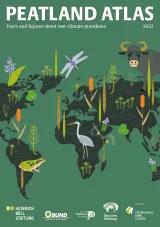
One-third of the world’s peatlands are in North America. Those landscapes close to urban areas have suffered severe degradation, and urgent repair work is needed to restore them. In the north of the continent, peatlands are increasingly threatened by the oil and mining industries.

North America’s peatlands take on a wide variety of forms: from the fens and sedge marshes of the Everglades, to the cypress swamps of the eastern United States, to the bogs and fens of the boreal forests of Canada and Alaska, which make up the majority of North America’s peatlands. The whole continent has a total of 158 million hectares of peatlands, which are currently estimated to store 185 billion tonnes of carbon.
Although more than 98 percent of North America’s peatland remains intact, drainage in more populated regions has resulted in significant degradation. Nearly 2 million hectares have been drained for agriculture, which accounts for most of the area converted, while additional areas have been lost to development.
The remaining peatlands are increasingly threatened by the northward spread of the oil and mining industries. These have already disturbed at least 500,000 hectares of peatland and may expand further in the coming decades. There are numerous mining claims on peatlands in Canada. Resource exploration and access to mine sites require additional infrastructure such as roads, which further affect the landscape in ways that are still poorly understood. Large areas of boreal forest have been flooded to create reservoirs for hydroelectric power plants. Such disturbances have contributed to the decline in the number of woodland caribou in Alberta.
Climate crisis poses an additional threat to North America’s peatlands. In the south, warm, dry summers can dry out the peat and exacerbate the risk and severity of wildfires. In the north, much of the peat is underlain by permafrost. As this thaws in a warming climate, it changes the hydrology and releases large quantities of carbon in the following years. However, climate crisis may also cause the peatland to expand northwards. It is uncertain whether the peat will continue to absorb carbon as the climate continues to change.
Major peatland areas in North America include the Everglades and the Hudson Bay Lowlands. The Everglades, in southern Florida, is a subtropical peatland that developed about 5,000 years ago. It has been designated as a wetland area of global importance by the Ramsar Convention. Originally 1.1 million hectares, almost half has been converted to agricultural and urban use. A huge system of drainage canals was begun in the late 1800s, and by the early 1980s most of the remaining Everglades had been surrounded by dykes. Massive drainage and water management efforts were undertaken to prevent flooding of agricultural land and coastal settlements. The supply of water to the Everglades was reduced, causing some peatlands to dry out and decompose or burn. This in turn led to enormous carbon losses: The Everglades have lost 75 percent of peat stocks, releasing 1.3 billion tonnes of carbon dioxide (CO₂) into the atmosphere. This poor water management has made the Everglades one of the largest wetland contributors to emissions in North America. In 2000, the US Congress authorized the Comprehensive Everglades Restoration Plan to restore, preserve and protect the wetland ecosystem. A key measure is to reestablish the natural hydroperiod, which will reduce greenhouse gas emissions while providing for the region’s other water-related needs, including water supply and flood protection. At a cost of 23.2 billion US dollars and due to be completed by 2050, it will be the largest hydrological restoration project ever undertaken in the United States.
The Hudson and James Bay Lowlands in Canada are one of the largest continuous peatland complexes in the world. It stores an estimated 30 billion tonnes of carbon, or more than 15 percent of the carbon contained in all North America’s peatlands. The area covers 33.5 million hectares along the Hudson and James Bay coastlines. This region is home to Indigenous communities who have been stewards of the land since time immemorial. The peat has developed over the last 7,000 years, slowly accumulating up to 3 metres of organic matter. The depth and age of the peat are strongly influenced by the legacy of the last ice age, where land was exposed along the coast as it rebounded from the weight of the ice sheet. This process still is occurring today, with the land rising at a rate of 1.2 metres every 100 years. The slow accumulation of peat over millennia means that the carbon stored in the soil is particularly vulnerable to development, as the organic matter cannot be replenished in the timescale needed to mitigate climate crisis. Although the region remains relatively pristine, threats include mineral exploration and development. Protecting these peatlands will be critical for mitigating climate change. Conservation should be led by Indigenous people to protect the social and ecological values of the landscape for the people who live there.

